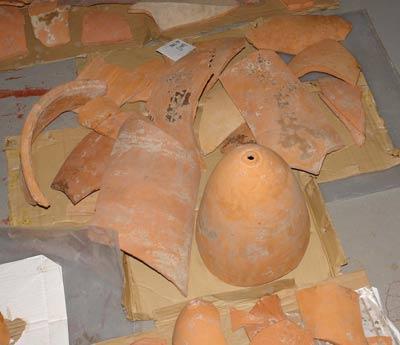Dig at the dock - update

Mark Adams from the archaeology team with an update on activity at the Manchester Dock site. Photos from the dig are still on our Flickr page. If you've missed any of the excavation posts follow the 'museum of liverpool' link at the foot of this post.
After a lull of about three weeks whilst we recorded the dock structures exposed in the first phase of the dig, excavation has begun for the new museum foundations. This is being undertaken as a 'Watching Brief' which entails the Museum's archaeologists monitoring the excavation of the site by machine. The site is being excavated in this way because test-pits and boreholes taken earlier in the project showed that the quaysides were constructed over dumps of sands, gravels and rubble dumped into the Mersey to form this part of the docks. The vast majority of this material is of little or no archaeological interest, most is probably dredgings taken from the river, and hand digging of this material is not realistically feasible or productive. However, it does contain pockets of very interesting deposits. So far we have found more sugar moulds (below) similar to those found earlier in the excavation, including one which although broken may be complete, and another with a complete makers stamp for W. Ashcroft of Prescott.

An intact sugar mould. Tried to find an image of the type of sugar cone that would have come out of a mould like the one shown, and this was the best I could find (I'm not suggesting you buy one of course - purely for information purposes).
Several dumps of broken pottery have been found, some containing thousands of pieces. Most of this appears to be from the Herculaneum Pottery which was an important Liverpool pottery working for 44 years from 1796. There also appears to be pottery from Staffordshire, possibly because of Manchester Dock's connection with the Shropshire Union Canal. Others may be imports from China, but we need to send these to a specialist to be sure of this. In addition to the pottery dumps of clay tobacco pipe have also been found. This will require examination by a specialist in tobacco pipes, but appears to contain material relating to manufacture of the pipes.
Material like this is of great value to archaeologists and historians, because we know this section of the dock was constructed between 1803-1813 we can give a very accurate date to the things which are found. The results of this work can then be fed into other excavations, hence providing valuable dating evidence.
In the past couple of days we have exposed a section of the waterfront pre-dating the addition of lock gates to Manchester Dock in 1803-1813. We know from maps and other documents that the wall was built in about 1785. Unfortunately very little of it seems to have survived, most having being destroyed by the early 19th century builders.
